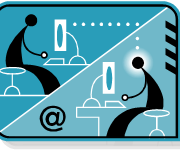Six Tips for Holding Successful Meetings with Staff Members
By Helena Ferrari
The following tips for holding successful meetings will help you and help your reporting staff members to succeed when they are most empowered.
Regular one to one employee meetings are very important. These meetings set the forum for a communication channel from management to employees, as well as from employees to management. For an employee being informed creates a feeling of involvement and increases the sense of ownership that stimulates productivity.
To maximize the time and productivity of both parties, the meeting works best when it’s organized. This time spent together can be considered a fact finding and an employee empowering session. These are the times that you can work together with your staff member to prepare them to take ownership and empower them to go out and perform.
1. What’s the objective?
The first step is to decide what are you trying to accomplish in these meetings? The goal is important to ascertain before meetings as this goal will focus the staff member towards attainment. This helps to review progress on hitting a project milestone and set the next steps for keeping the project on track.
2. What’s the ideal outcome?
This serves as a reminder especially when it comes to dealing with tough issues which you are seeking a positive result. Sometimes personal emotions take control of the real issue and as a result it is easy to lose sight of the positive goal you are seeking. This forum is a chance to recognize accomplishments, set future direction, and maintain accountability. For example: If you’re dealing with a situation in which confusion exists, the positive outcome is a plan that provides clear direction.
3. How should the manager prepare?
You may have stimulating questions to ask, information to provide, or something to teach; you may need to give direction or spell out expectations. Sometimes you may need to prepare by reminding yourself to listen and be patient. Whatever the case, come prepared. As part of this exchange it is important to remember that coaching takes place through two-way conversations so try not to dominate the conversation.
4. What should the employee prepare?
In order to get the most out of these meetings you may send some questions or an outline in advance for the areas you would like to cover during the meeting. No matter what plan or agenda you seek for this session it is important to encourage employee participation?
5. How is this meeting valuable to the employee?
Ultimately, you want your employees to drive the one-on-one meetings. You want them to bring to the meeting the issues, challenges, opportunities and ideas to discuss. In essence, the meeting is a two-way street as the employee’s role is to take responsibility; yours is to provide support and add value that helps the employee perform well.
6. What follow-up should be set?
There should be action items for both the manager and staff member before completing the meeting. If the employee discusses issues or opportunities for improvement, he/she should come prepared next time with ideas for possible solutions and even changes that they have already implemented. This enables the employee to take ownership and feel empowered which in turn results in increased productivity and an improved level of pers onal responsibility. It is possible that the manager may have to assist with driving some of the exchange of ideas resulting in management action items. Both parties should agree on a list of the deliverables for which the employee and the manager are to report progress in the next meeting. Once you have agreed on the action items, communicate a going forward plan that puts the idea into action or allows the employee to bring proposals into the next meeting.
onal responsibility. It is possible that the manager may have to assist with driving some of the exchange of ideas resulting in management action items. Both parties should agree on a list of the deliverables for which the employee and the manager are to report progress in the next meeting. Once you have agreed on the action items, communicate a going forward plan that puts the idea into action or allows the employee to bring proposals into the next meeting.
As the meeting closes, set a follow-up time to check progress. Doing this allows you to stay connected, builds in accountability for the employee, and for you as a manager and shows that you care about the outcome.
Permission is needed from Lighthouse Consulting Services, LLC to reproduce any portion provided in this article. © 2014
Helena Ferrari, PHR Director of Human Resources has worked with many businesses globally throughout her twelve-year career as a Human Resources Professional. Through the Human Resources function’s role as a strategic business partner, Helena develops change initiatives and performance enhancing programs that improves organizations competitiveness through people. For more information, contact Helena at hferrariqp@gmail.com.
If you would like additional information on this topic or others, please contact your Human Resources department or Lighthouse Consulting Services LLC, 3130 Wilshire Blvd., Suite 550, Santa Monica, CA 90403, (310) 453-6556, dana@lighthouseconsulting.com & our website: www.lighthouseconsulting.com.
Lighthouse Consulting Services, LLC provides a variety of services, including in-depth work style assessments for new hires & staff development, team building, interpersonal & communication training, career guidance & transition, conflict management, 360s, workshops, and executive & employee coaching. Other areas of expertise: Executive on boarding for success, leadership training for the 21st century, exploring global options for expanding your business, sales and customer service training and operational productivity improvement.
To order the books, Cracking the Personality Code and Cracking the Business Code, please go to www.lighthouseconsulting.com.



